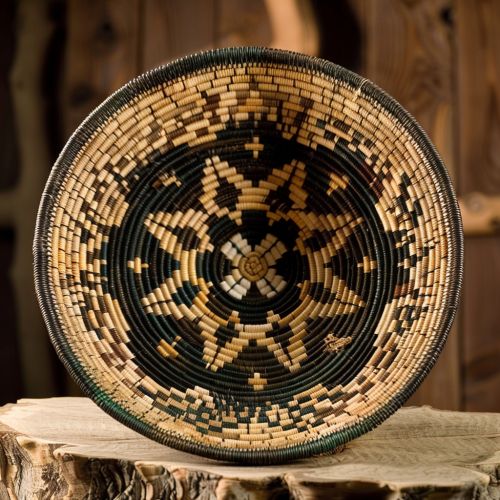Cherokee: Difference between revisions
No edit summary |
No edit summary |
||
| Line 37: | Line 37: | ||
Cherokee art and craftsmanship are renowned for their intricate designs and symbolic meanings. Basket weaving, pottery, beadwork, and wood carving are some of the traditional crafts practiced by the Cherokee. These art forms often incorporate motifs and patterns that reflect the tribe's connection to nature and their spiritual beliefs. | Cherokee art and craftsmanship are renowned for their intricate designs and symbolic meanings. Basket weaving, pottery, beadwork, and wood carving are some of the traditional crafts practiced by the Cherokee. These art forms often incorporate motifs and patterns that reflect the tribe's connection to nature and their spiritual beliefs. | ||
[[Image:Detail-79373.jpg|thumb|center|Traditional Cherokee basket weaving with intricate patterns and natural materials.]] | [[Image:Detail-79373.jpg|thumb|center|Traditional Cherokee basket weaving with intricate patterns and natural materials.|class=only_on_mobile]] | ||
[[Image:Detail-79374.jpg|thumb|center|Traditional Cherokee basket weaving with intricate patterns and natural materials.|class=only_on_desktop]] | |||
== Historical Events == | == Historical Events == | ||
Latest revision as of 06:18, 18 May 2024
Overview
The Cherokee are a Native American people historically settled in the Southeastern United States, primarily in present-day Georgia, North Carolina, South Carolina, and Tennessee. They are part of the Iroquoian language family, which includes other tribes such as the Mohawk and Seneca. The Cherokee Nation, with its rich cultural heritage, complex social structures, and significant historical impact, remains a vital part of American history and contemporary society.
Early History
Pre-European Contact
The Cherokee people have inhabited the southeastern United States for thousands of years. Archaeological evidence suggests that their ancestors were part of the Mississippian culture, known for constructing large, complex mound-building societies. These early Cherokee communities were organized into clans, each with specific roles and responsibilities within the tribe.
European Contact
The first recorded contact between the Cherokee and Europeans occurred in the 16th century with the arrival of Spanish explorers such as Hernando de Soto. This period marked the beginning of significant changes for the Cherokee, including the introduction of new diseases, trade goods, and technologies. The Cherokee adapted to these changes by incorporating European goods into their daily lives while maintaining their cultural practices.
Social Structure
Clans and Kinship
The Cherokee social structure is matrilineal, meaning that lineage and inheritance are traced through the mother's line. There are seven primary clans: Wolf, Deer, Bird, Long Hair, Wild Potato, Blue, and Paint. Each clan has specific duties and responsibilities, and clan membership plays a crucial role in social and political life.
Governance
Traditional Cherokee governance was based on a council system, with representatives from each clan participating in decision-making processes. The council was led by two chiefs: a peace chief, who handled internal affairs and diplomacy, and a war chief, who led during times of conflict. This dual-chief system ensured a balance between peace and war efforts.
Language and Writing
The Cherokee language, part of the Iroquoian language family, is known for its unique syllabary, created by Sequoyah in the early 19th century. The syllabary consists of 85 characters, each representing a syllable rather than an individual phoneme. This writing system enabled the Cherokee to achieve high levels of literacy and facilitated the publication of newspapers, legal documents, and religious texts in their language.
Cultural Practices
Religion and Spirituality
Traditional Cherokee religion is deeply rooted in animism, the belief that all elements of the natural world possess a spiritual essence. The Cherokee cosmology includes a variety of deities and spirits, with the Great Spirit being the most significant. Rituals and ceremonies, such as the Green Corn Ceremony, play a vital role in maintaining harmony between the people and the natural world.
Art and Craftsmanship
Cherokee art and craftsmanship are renowned for their intricate designs and symbolic meanings. Basket weaving, pottery, beadwork, and wood carving are some of the traditional crafts practiced by the Cherokee. These art forms often incorporate motifs and patterns that reflect the tribe's connection to nature and their spiritual beliefs.


Historical Events
Trail of Tears
One of the most significant and tragic events in Cherokee history is the Trail of Tears. In the 1830s, under the Indian Removal Act signed by President Andrew Jackson, the Cherokee were forcibly removed from their ancestral lands and relocated to present-day Oklahoma. This journey, marked by extreme hardship and suffering, resulted in the deaths of thousands of Cherokee people.
Civil War and Reconstruction
During the American Civil War, the Cherokee Nation was divided, with some members supporting the Union and others siding with the Confederacy. This internal conflict further strained the tribe's unity. After the war, the Cherokee faced numerous challenges during the Reconstruction era, including the loss of land and resources.
Modern Era
Cherokee Nation Today
Today, the Cherokee Nation is one of the largest federally recognized tribes in the United States, with a population of over 300,000 members. The tribe's government operates under a constitution and is led by a Principal Chief, Deputy Chief, and Tribal Council. The Cherokee Nation provides various services to its members, including healthcare, education, and housing.
Cultural Revitalization
Efforts to preserve and revitalize Cherokee culture are ongoing. Language immersion programs, cultural festivals, and educational initiatives aim to ensure that future generations remain connected to their heritage. The Cherokee Heritage Center and other institutions play a crucial role in these efforts.
